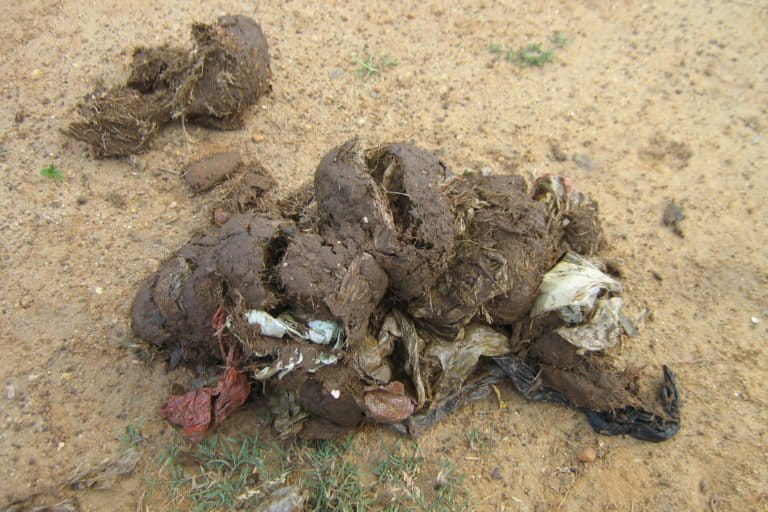- Across Sri Lanka, municipal waste is regularly discarded in open garbage dumps, many of which are located near protected areas and other wildlife habitat, drawing elephants there in search of food.
- The deaths of several such foraging elephants has garnered global attention, thanks to a recent AP news report tweeted out by Leonardo DiCaprio, but local conservationists say they’ve been warning about the problem for a long time.
- A former head of the Department of Wildlife Conservation says decisions on where to establish new dump sites often ignore wildlife concerns, driven by “short-sighted, politically motivated” planning.
- But just keeping the elephants out of the dumps isn’t a solution; many of these animals are accustomed to raiding local farms for crops — a habit that they very quickly return to when dump sites are shut down, leading to yet another problem of human-elephant conflict.
COLOMBO — It took a tweet from Hollywood superstar Leonardo DiCaprio to bring the issue of trash-foraging elephants in Sri Lanka to global attention. But local conservationists have long been flagging the problem, one they say is rooted in “short-sighted, politically motivated” planning that continues to take its toll on both elephants and people.
On Jan. 26, Oscar winner and environmentalist DiCaprio tweeted to his nearly 20 million Twitter followers a report by the Associated Press on the growing problem of wild Asian elephants (Elephas maximus) dying after feeding in open garbage dumps. Elephants are revered in Sri Lanka, and often feature in cultural and religious events. Yet many of the animals feed alongside stray dogs and crows at these garbage dumps, many of which are located near conservation sites and other protected areas that are home to wildlife.

“We conducted a survey around Sri Lanka and listed 54 garbage open garbage dumps visited by elephants,” Chandana Sooriyabandara, director-general of Sri Lanka’s Department of Wildlife Conservation (DWC), told Mongabay. “The department has nothing to do with the setting up of these garbage dumps, but we have to eventually deal with them as elephants frequent the dumps. We are trying to minimize the impact, but it is an uphill task as 70% of Sri Lankan elephants can also be found outside protected areas.”
While the AP reported that elephants were dying after eating plastic trash at the sites, it’s not the plastic itself, primarily polythene, says veterinary surgeon Tharaka Prasad, the current director of health at the DWC.
“A number of elephants die each year on these garbage sites, but the reason of their death is not the polythene indigestion, but food poisoning,” Prasad told Mongabay. “Lots of food waste is carelessly discarded. This waste is often tightly sealed inside polythene bags. When the food goes bad inside the oxygenless environment, the bacteria can create toxic substances and we often found this the actual reason behind the deaths of garbage-eating elephants.”
Ruminants like cows have several chambers in their digestive system that can result in the accumulation of polythene in their gut, which can ultimately be lethal. But an elephant’s digestive system is much simpler, and the polythene passes through when the animal defecates. But the plastic isn’t without its risks, as it can sometimes result in constipation, Prasad said.

‘Short-sighted decision’
In Sri Lanka, municipal waste is often disposed of in open garbage dumps by local government authorities. Because these sites are unhygienic and foul-smelling, local planners try to locate them in areas away from human settlements. This results in dump sites being established in areas frequented by wildlife, including elephants.
“If we take care of the garbage we generate in the urban and semi-urban areas where garbage is generated in large quantities, the question of elephants eating garbage or elephants visiting garbage dumps for fodder may not arise,” Sumith Pilapitiya, former director-general of the DWC, told Mongabay. “Garbage should be disposed of in the areas where it is generated and not near nature reserves or areas recognized as habitats for wild animals.”
Pilapitiya said that during his time at the DWC, the department often objected to new dump sites being set up in and near conservation areas, but was often ignored. He recalled the decision over where to dump waste from Dambulla, a town in Central province, where municipal planners had narrowed down two potential sites: one in a forest reserve in Digampathana, and the other on the Dambulla-Matale road, a vacant site but dotted with human settlements. Despite the DWC’s objections, the planners decided to set up the dump at Digampathana. Today, about 30 elephants regularly forage among the trash there.
The decision also created additional expenses for local authorities, who have had to set up an electric fence around the site to keep the elephants out and protect workers and equipment.
“A truly short-sighted, politically motivated decision resulted in creating a fresh problem with elephants in Digampathana with additional expenses having to be borne to support that bad decision for electric fences,” Pilapitiya told Mongabay. “The best and the cheapest solution is to avoid creating new problems in environment management.”

Eat trash or raid crops
It’s extremely rare for elephants to die while feeding at a garbage dump, says elephant biologist Prithiviraj Fernando of the Centre for Conservation and Research (CCRSL).
Fernando, a global authority on the species, who serves on the IUCN’s Asian Elephant Specialist Group, said elephants feed very selectively at garbage dumps. “If you compare the health status (body condition) of elephants at the garbage dumps with the ones found in the parks in the same area, the ones at the garbage dumps are in much better condition,” he told Mongabay. Short of locating these sites away from elephant habitat, the best thing to do is to sort the garbage, so the elephants can feed on the organic waste separately, he said.
Fernando and colleagues have studied elephant behavior at several dumps in southern Sri Lanka. They found the Uddakandara garbage dump, located near Yala National Park, is frequented by 26 elephants, and the one in Wellawaya in has around 24 elephants. The team also monitored the now-defunct dump in Kataragama, where more than 45 elephants used to feed. They calculated that with an average of 20 elephants feeding at 54 dump sites throughout Sri Lanka, that gives a population of about 1,000 garbage-eating elephants.

The study also found that almost all the elephants visiting garbage dumps are bull elephants. Most of them have gunshot wounds, the tell-tale sign of a crop-raiding animal that has been shot at by farmers. This complicates the question of how to keep elephants out of dump sites without driving them back into farmers’ fields.
“If you close these dumps, then these elephants will spend the time they are spending at the dump on crop raiding, so it will dramatically increase human-elephant conflict resulting in more deaths — of people and elephants,” Fernando said.
He cited the Uddakandara and Kataragama sites as textbook examples of what can happen in such cases. The government shut down the Uddakandara dump to stop the elephants from foraging in the trash. The elephants duly returned to raiding crops, prompting protests by villagers. Faced with this pressure, authorities reopened the dump site and the elephants returned to eating garbage. It was the same story in Kataragama, Fernando said, except the site remains shut.

“The Kataragama dump was closed, and after that, the human-elephant conflict in the area dramatically increased, together with an increase in crop raiding,” he said. “People have to invest more in putting up electric fences to safeguard their crops and houses, and both elephants and people are getting killed.”
Fernando added that, “In a way, these dumps actually reduce direct human-elephant conflict. But these dumps need to be better managed.”
Citation:
Liyanage, D. J., Fernando, P., Dayawansa, P. N., Janaka, H. K., & Pastorini, J. (2021). The elephant at the dump: How does garbage consumption impact Asian elephants? Mammalian Biology, 101(6), 1089-1097. doi:10.1007/s42991-021-00114-5
Banner image of elephants feeding in a garbage dump alongside stray dogs, cattle and egrets, courtesy of the Centre for Conservation and Research (CCRSL).
